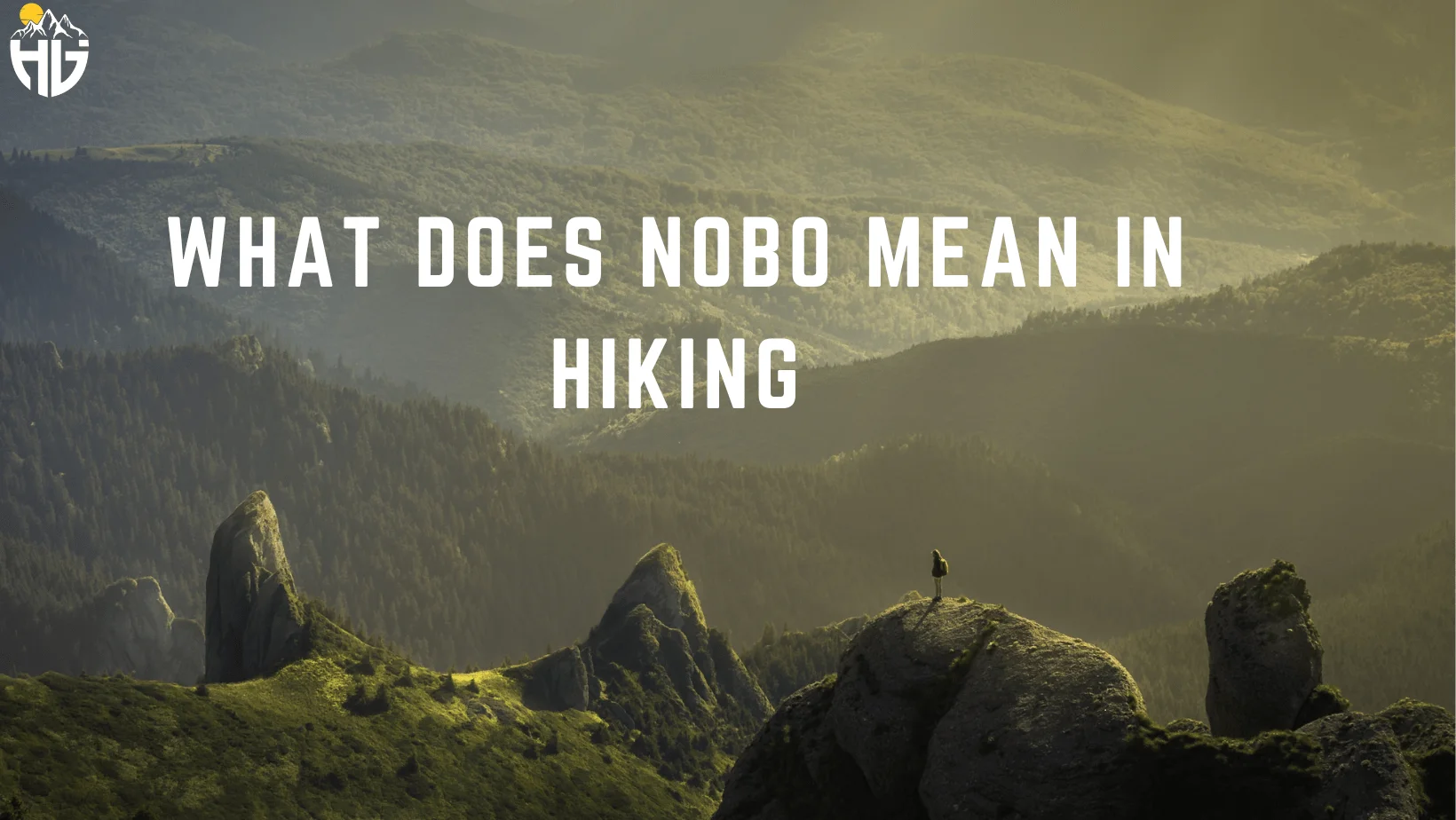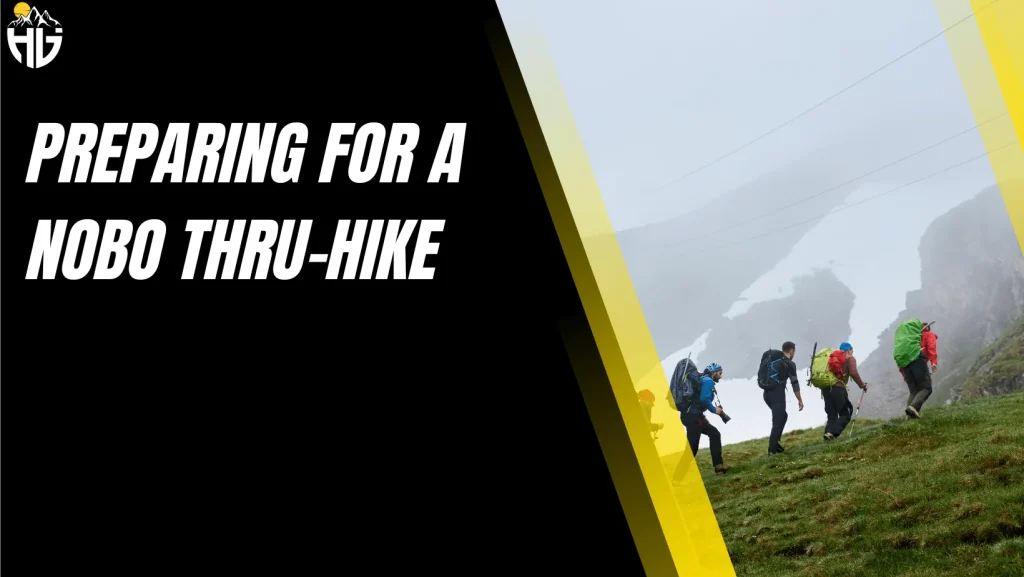What Does NOBO Mean in Hiking

Are you planning on taking a hike anytime soon? Do the terms NOBO, hiking SOBO, and flip-flop sound like gibberish to you? Well, fear no more! Understanding hiking terminology is crucial when preparing for any outdoor adventure. And what does NOBO mean in hiking, you ask? No worries! It’s simply an abbreviation for “northbound,” which refers to the thru hikers who travel from south to north along a trail.
This term is commonly used in the hiking community as it helps identify where fellow hikers are headed and allows them to plan accordingly. Knowing this one simple term can make all the difference in your next conversation with fellow hikers and help ensure a successful trip on the trails. So pack your bags and hit those hills.
What Does NOBO Mean in Hiking?
Definition and Explanation of the Term
NOBO, an acronym for Northbound thru hiker, describes hikers who journey from the southern terminus to the northern terminus of a long-distance trail. This term holds substantial importance within the hiking community, as it not only indicates direction but also influences the overall hiking experience.
Origins of the Term in the Hiking Community
The term NOBO emerged from the increasing popularity of long-distance trails such as the Appalachian Trail and the Pacific Crest Trail. As more adventurers embarked on these epic journeys, the need for a shorthand to describe their direction became crucial, and thus, NOBO was born.
Comparison with Other Directional Terms: SOBO, EABO, and WABO
While NOBO is a widely used term, it’s not the only directional abbreviation in the hiking world. Other common terms include:
SOBO Hiker (Southbound): This term refers to southbound hikers who travel from the northern terminus to hike southbound terminus of a trail. The choice to hike SOBO can be influenced by factors such as preferred starting points, weather conditions, or the desire for a different social experience.
EABO (Eastbound) and WABO (Westbound): These terms are less frequently used, as they apply to fewer trails. Nevertheless, they represent hikers moving in an eastward or westward direction along specific trails, like the American Discovery Trail, which spans from coast to coast.
Each directional term carries its unique set of challenges and rewards, shaping the experiences of hikers who choose to tackle long-distance trails in these distinct ways.
The Importance of NOBO in Thru-Hiking

The Role of NOBO in Long-Distance Trails
NOBO plays a significant role in the world of long-distance trails, particularly in well-known paths like the Appalachian Trail and the Pacific Crest Trail. Choosing to hike NOBO often means starting in milder climates and working towards more challenging conditions, making it a popular choice for many hikers.
Additionally, since the majority of hikers on these trails choose to go NOBO, they have a more extensive support network and opportunities for shared experiences.
Impact on Hiker Interactions and Social Dynamics on the Trail
The choice to hike NOBO can greatly influence the social dynamics on the entire trail. With a larger number of day hikers moving in the same direction, there is a higher chance of forming bonds and friendships, fostering a sense of camaraderie among the hiking community.
This shared journey creates a supportive environment that can prove invaluable during the physical and mental challenges of a thru-hike.
The Influence of NOBO on Thru Hiker Mentality and Motivation
Embarking on a NOBO hike can impact a hiker’s mentality and motivation as well. As they progress from milder to more challenging conditions, hikers must adapt and grow, developing resilience and determination along the way. Reaching the northern terminus of a trail can symbolize the culmination of their efforts, and the anticipation of this achievement serves as a powerful motivator throughout their journey.
Moreover, the shared experience of overcoming obstacles and celebrating milestones with fellow NOBO hikers can contribute to a heightened sense of accomplishment and personal growth.
The Role of Trail Towns & Trail Magic in the NOBO Hiking Experience
Trail towns are communities located along or near long-distance hiking routes, offering essential services, resources, and support to hikers. They play a crucial role in the NOBO hiking experience, particularly on popular trails like the Appalachian Trail and the Pacific Crest Trail.
Services and amenities: Trail towns provide hikers with access to grocery stores, restaurants, lodging, and medical services, making them essential stops for resupplying and recuperating during a thru-hike.
Local support and hospitality: Trail towns often have a strong sense of community and are welcoming to hikers. Locals may offer assistance, transportation, or even a place to stay, contributing to the overall positive experience of NOBO hikers.
Cultural enrichment: Visiting trail towns allows hikers to immerse themselves in the local culture and history, providing a unique opportunity to learn about the regions they traverse and connect with the communities that call these areas home.
Hiking Seasons and NOBO
Best Times to Hike North on Popular Trails
Choosing the optimal time to start a NOBO hike is crucial for a successful and enjoyable experience. Here are the best times to embark on NOBO journeys for two popular trails:
Appalachian Trail
Starting between April and May is generally ideal, as it allows trekkers to avoid harsh winter conditions in the North while also providing enough time to complete the trail before winter returns.
Pacific Crest Trail
The optimal window for starting a NOBO hike on this trail is narrower, typically between late April and early May. This timing helps trekkers avoid heavy snow in the Sierra Nevada mountains and extreme heat in the Southern California desert.
Springer Mountain in Georgia
It serves as the southern terminus of the Appalachian Trail. Beginning your NOBO journey here in the spring months offers not only pleasant weather conditions but also the opportunity to witness the breathtaking beauty of wildflowers and lush greenery that spring in the Southern Appalachians is known for.
How to Prepare for the Unique Challenges of NOBO Hiking
To tackle the distinctive challenges of hiking NOBO, thorough preparation is essential. Here are some tips to help you get ready:
Research trail conditions: Familiarize yourself with the terrain, potential weather conditions, and seasonal challenges you may encounter during your hike. This knowledge will help you plan accordingly and make informed decisions on the trail.
Select appropriate gear: Tailor your gear to the specific challenges of your chosen trail and expected weather conditions. For instance, pack layers to manage fluctuating temperatures, and invest in quality rain gear and footwear to ensure comfort and safety.
Physical training: Gradually increase your fitness levels in the months leading up to your hike. Incorporate activities such as hiking, strength training, and cardiovascular exercises to prepare your body for the rigors of the trail.
Mental preparation: Long-distance hiking is as much a mental challenge as it is a physical one. Develop strategies to cope with the inevitable highs and lows of a thru-hike, and consider connecting with thru hikers for advice and support.
Benefits and Drawbacks of NOBO Hiking

Potential Challenges and Disadvantages
Despite its many advantages, NOBO hiking also has some drawbacks:
Overcrowding: The popularity of NOBO routes can lead to crowded trails, particularly during peak hiking seasons. This may diminish the sense of solitude and tranquility that some hikers seek in the wilderness.
Increased Competition for Resources: The large number of NOBO hikers can result in greater competition for resources, such as limited camping spots or shelters, especially in the early stages of a thru-hike.
Potential Impact on Environment: The concentration of thru hikers in specific areas and times can increase the risk of environmental degradation if Leave No Trace principles are not followed diligently.
Tips for Determining Whether NOBO is the Right Choice
Deciding whether to embark on a NOBO hike depends on several factors, including personal preferences and goals. Here are some tips to help you make the decision:
Evaluate your priorities: Consider what aspects of the hiking experience are most important to you, such as weather conditions, terrain, solitude, or social interaction.
Research alternative options: Investigate other directional options, such as SOBO hiking, EABO, or WABO, and compare their unique challenges and rewards to those of NOBO hiking.
Assess your physical fitness and experience: Reflect on your current fitness level and experience in long-distance hiking, and determine whether you feel prepared to tackle the specific demands of a NOBO journey.
Connect with Thru hikers: Seek advice from the most thru hikers who have completed NOBO hikes, as well as those who have chosen alternative routes, to gain insight into the different experiences and perspectives that each direction offers.
Preparing for a NOBO Thru-Hike

Selecting the right gear is essential for a successful and enjoyable NOBO thru-hike. Consider the following recommendations when choosing your equipment:
Backpack: Opt for a comfortable, durable, and lightweight backpack with a suitable capacity for your gear and supplies.
Footwear: Invest in high-quality hiking boots or trail shoes that provide adequate support, traction, and protection for various trail conditions.
Clothing: Choose moisture-wicking, quick-drying, and breathable clothing to maintain comfort and regulate body temperature. Don’t forget to pack layers for changing weather conditions and temperatures.
Shelter and sleep system: Select a lightweight tent or hammock, a sleeping pad with appropriate insulation, and a sleeping bag rated for the lowest temperatures you might encounter.
Navigation tools: Carry a reliable map, compass, and potentially a GPS device for navigation and safety purposes.
Cooking and hydration: Bring a lightweight stove, cooking utensils, and a water filtration or purification system to ensure proper nutrition and hydration on the trail.
Training and Fitness Preparation
Physical preparation is vital for a successful NOBO thru-hike. Implement the following training and fitness tips in the months leading up to your hike:
Hiking: Incorporate regular hikes with a loaded backpack to simulate trail conditions and build endurance.
Cardiovascular training: Engage in regular aerobic exercises, such as running, cycling, or swimming, to improve your cardiovascular fitness.
Strength training: Develop overall body strength with a focus on the legs, core, and upper body to support the demands of a long-distance hike.
Flexibility and balance: Include stretching and balance exercises, such as yoga or Pilates, to enhance flexibility and prevent injuries.
Building a Support Network and Staying Connected with Fellow Hikers
A strong support network can be invaluable during a NOBO thru-hike. To build and maintain connections with fellow hikers:
Join online forums and social media groups: Participate in discussions, ask questions, and share your experiences with others who are planning or have completed similar hikes.
Attend local hiking events or meetups: Connect with like-minded individuals in your area to share advice, exchange gear recommendations, and potentially find hiking partners.
Maintain contact with trail friends: Stay in touch with the people you meet on the trail through phone, email, or social media to share updates, encouragement, and valuable insights.
Leverage trail angel networks: Take advantage of the kindness and support of trail angels, who often provide assistance to long-distance hikers in the form of food, water, or shelter.
Frequently Asked Questions
What is the Appalachian Trail Conservancy (ATC)?
The Appalachian Trail Conservancy (ATC) is a non-profit organization founded in 1925, dedicated to preserving and managing the entire Appalachian Trail. Their mission is to ensure that the trail’s natural beauty and cultural heritage are protected and enjoyed for generations to come. They work in partnership with numerous federal, state, and local agencies, as well as thousands of dedicated volunteers.
Do I need a permit to hike the Appalachian Trail?
While most of the Appalachian Trail does not require permits, a few specific areas do:
- Great Smoky Mountains National Park: A permit is required for overnight stays in the park.
- Shenandoah National Park: A permit is needed for backcountry camping.
- Baxter State Park: A permit is required to summit Mount Katahdin, the northern terminus of the trail.
Always check the current regulations and requirements for the specific sections you plan to hike.
What is the Continental Divide Trail (CDT)
The Continental Divide Trail (CDT) is a long-distance hiking and equestrian trail that traverses the United States from the Canadian border in Montana to the Mexican border in New Mexico. The trail follows the Continental Divide along the Rocky Mountains, covering approximately 3,100 miles (4,988 km) through five states: Montana, Idaho, Wyoming, Colorado, and New Mexico.
Conclusion
Understanding the concept of NOBO and its significance within the hiking community is vital for both experienced and novice hikers alike. As one of the most popular hiking directions, NOBO offers a unique blend of challenges and rewards, including favorable weather conditions, trail camaraderie, and opportunities for personal growth.
If you’re contemplating a long-distance hike, we encourage you to consider NOBO as an option. While it may present certain drawbacks, such as overcrowding or competition for resources, the overall experience can be incredibly fulfilling and memorable. Keep in mind the importance of thorough preparation, from choosing the right gear and honing your physical fitness to familiarizing yourself with the trail and its unique challenges.
Lastly, we invite you to share your own NOBO experiences or plans with fellow hikers, whether online or in person. By exchanging stories, tips, and encouragement, we can help one another make the most of our adventures and contribute to the vibrant and supportive hiking community.




